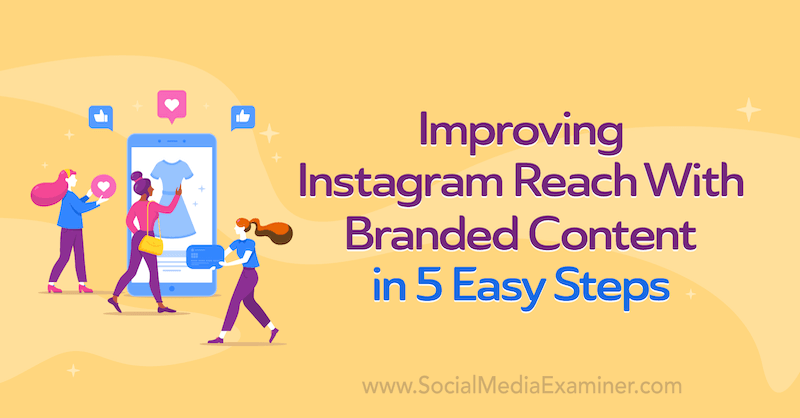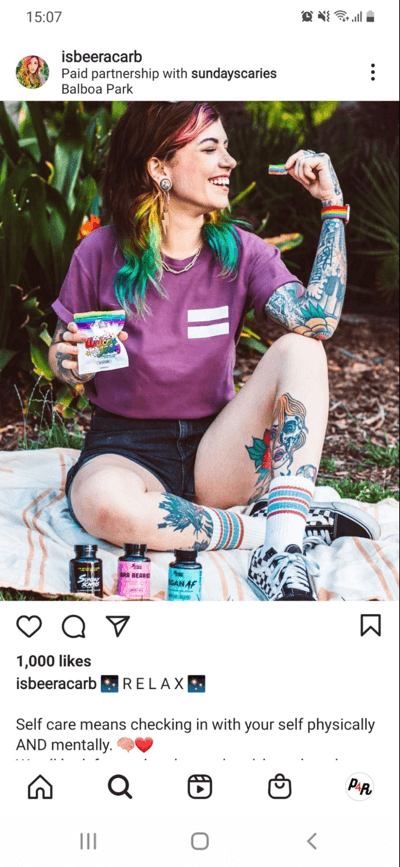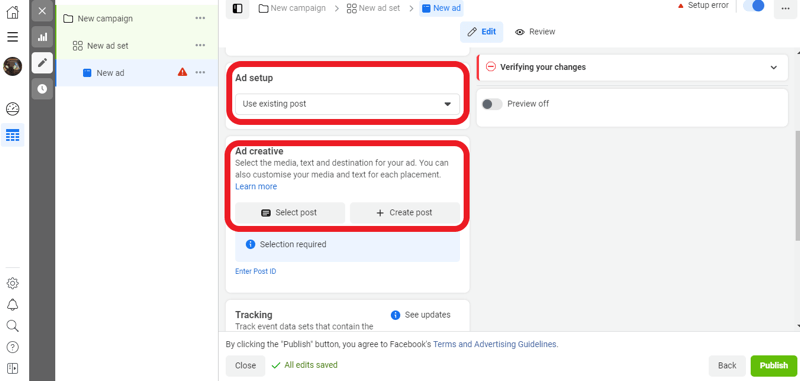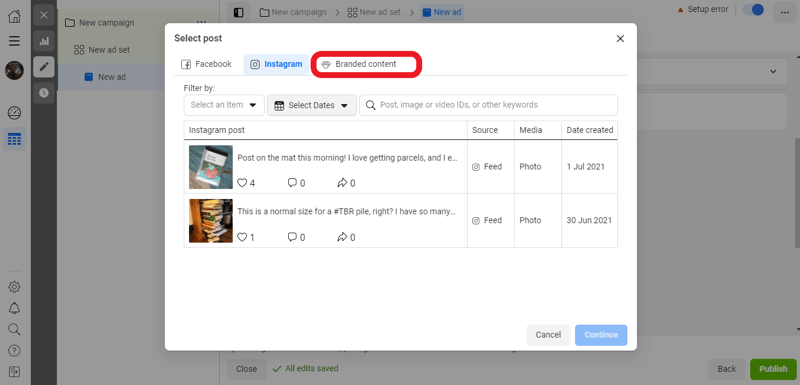Want to reach new audiences on Instagram without running ads? Have you considered branded content but weren't sure where to start?
In this article, you'll learn five simple steps to create, launch, and promote Instagram branded content campaigns to reach new people.

What Is Branded Content on Instagram?
Here's what you need to know before you dive into the world of branded content creation, influencer marketing, and Instagram settings.
Branded content is one of the most powerful tools for Instagram marketing. It bridges the gap between organic content and paid ads, commercial partnerships and authentic recommendations. But as you might imagine, building that bridge takes some skill.
You need to find the right partnerships, set guidelines for your content, and finally, have a plan for boosting and resharing branded content.
Let's start with some definitions. You might think that any content you produce as a social media manager is branded content: It's content by a brand.
But Instagram thinks differently. Within this social network, “branded content” has a specific meaning. It's content that markets your brand but it's not created or posted by you.

Influencers or creators create this content on your behalf. They receive “an exchange of value” in return, whether that's payment, product samples, or gifts. And that exchange of value has to be disclosed by using the branded content tools on Instagram.

It might sound a bit commercial—and indeed, many creators were outraged when Instagram first introduced branded content rules. But it's still an incredibly effective marketing method. Branded content enables you to speak to your target audience through someone they trust. And disclosing your partnership with that influencer can build trust further because you're demonstrating transparency.
But first things first: How do you choose a partner? Who's going to create and share your branded content?
#1: Find Effective Partners for Instagram Branded Content Campaigns
Like any other marketing campaign, your first step is to think about what you want to achieve. Who are you targeting? What do you want them to do? The answers to these questions will point you toward the right partners.
Get World-Class Marketing Training — All Year Long!
Are you facing doubt, uncertainty, or overwhelm? The Social Media Marketing Society can help.
Each month, you’ll receive training from trusted marketing experts, covering everything from AI to organic social marketing. When you join, you’ll also get immediate access to:
- A library of 100+ marketing trainings
- A community of like-minded marketers
- Monthly online community meetups
- Relevant news and trends updates
Instagram has some detailed recommendations for choosing a partner for your influencer campaign:
- Audience size and targeting. The biggest accounts aren't always the most effective. Look at audience demographics and engagement as well as size.
- Consistency with your organic presence. Unless you're running an influencer campaign to reach a completely new audience, there should be a high level of consistency among your brand account and the partners you choose.
- Transparency. Make sure you use the branded content tools such as paid partnership tags and follow Instagram's terms of service. Before you work with a creator, check that they're committed to following the rules, too.
- Relevance of your chosen partners to your brand. What's the connection between your brand and the creator? A similar audience and posting style aren't enough; you also need similar interests or to be in the same industry.
- Authenticity of branded content. Branded content is meant to look organic and genuine. Polished advertising slogans aren't it. In most cases, the best solution is to work with someone you trust to create their own content.
- Choosing partners who'll work with you long-term. Every marketer knows that keeping in touch is easier than finding someone new. It's true for customers and it's true for influencers.

Once you have a broad idea of what you're looking for, it's time to search for specific creators. Instagram offers its own free tool for this: Brand Collabs Manager.

Brand Collabs Manager is a tool to find, contact, and work with influencers on Instagram and Facebook. It also offers extra analytics for your branded content campaigns.
To use it, you'll have to apply first. You'll be asked for an active Facebook page, an email address, and consent to terms and conditions. It can take a few days for approval to come through.
Once you're in, you can search based on target audience, audience size, influencer demographics, topics of interest, and preferred post types. The platform will also recommend influencers who have similar audiences to you, high engagement levels, are gaining followers fast, or are similar to other partners you've worked with.
Brand Collabs Manager takes a lot of the pain out of partnerships. To start with, it sets minimum requirements for creators who want to be listed. There are slightly different requirements for Instagram and Facebook, but they both set a minimum audience size and engagement level.

Brand Collabs Manager also removes a lot of fluff from your communications. You don't have to message back and forth for weeks, hoping a creator spots your message in their DMs. Instead, when you choose to contact someone, Brand Collabs Manager gives you a detailed brief to fill out. So negotiations are in progress right away.
However, this isn't the only route to finding branded content partners. You can use one of the many paid influencer catalogs online (although you should check their engagement figures independently and make sure they're not just selling followers).
You can also find partners organically. One way to do this is through strategic branded hashtags.
Let's look at an example: fashion retailer Express. They have a thriving program of paid partnerships with influencers who reflect their style.

But note that those branded content posts also use two hashtags: #expresspartner and #expressyou. Now, not everyone can claim a paid partnership with Express but anyone can use a hashtag. Those hashtags create a pool of user-generated content on Instagram. Express can view it, share it, and recruit creators who catch their eye. Best of all, they know that any creators using their hashtag are probably already interested in a partnership.
#2: Enable Branded Content via Instagram Business Account Settings
Once you've chosen an influencer to work with, you need to make sure that your Instagram business account is set up for branded content. There are a few different settings to adjust here.
Start by going to Settings in Instagram, and then tap on the Business option. This is where you'll find the settings for branded content.

Discover Proven Marketing Strategies and Tips
Want to go even deeper with your marketing? Check out the Social Media Marketing Podcast! Publishing weekly since 2012, the Social Media Marketing Podcast helps you navigate the constantly changing marketing jungle, with expert interviews from marketing pros.
But don’t let the name fool you. This show is about a lot more than just social media marketing. With over 600 episodes and millions of downloads each year, this show has been a trusted source for marketers for well over a decade.

Under Status, you might discover that you're ineligible to be an influencer yourself (like me, for example!) but you can still work with influencers. In other words, you can be tagged in branded content but you can't create branded content for another business.
Below Status, you'll also see an option to manually approve content creators. If you leave this off, then anyone can tag you as a partner in their branded content. If you switch it on, then the option Approve Content Creators will appear. You can search these accounts and approve them individually.
If someone posts before you approve them, then their post will simply be labeled “paid partnership.” Your brand name won't appear until you've approved that creator.
#3: Choose the Content Formats for Your Instagram Branded Content
As we've seen, when you search for creators on Brand Collabs Manager, you can set Post Type as one of the parameters. In other words, you can choose whether to focus on feed posts, Reels, Stories, Live, or IGTV.

The “paid partnership” tag works for all of these post formats. But each one has a different style, audience, and likely conversion. Let's do a quick review:
- Feed posts will remain on the creator's profile page until deleted. This format includes photos, photo carousels, and extracts from video clips. They can prompt users to visit your Instagram profile.
- Stories only last 24 hours unless the creator saves them to Highlights. However, Stories can include web links, which gives them a major advantage over feed posts.
- Reels are Instagram's answer to TikTok. They're short videos with background music or special effects that often riff off other creators' videos. The audience for this format may skew slightly younger.
- Live videos are exactly what they sound like. Creators can save live videos for posterity. Like Stories, their impact tends to be short-term but you can't beat a live video for authenticity!
- IGTV is Instagram's built-in platform for longer video clips. This can be a great choice for content marketing such as how-tos, masterclasses, or unboxing videos. Although IGTV may offer a smaller audience than other formats.
As well as these points, you'll need to think about your brand's style. Do you normally focus on feed posts or share a lot on IGTV? Do you want your branded content to support your existing content strategy or fill gaps by using formats that you don't normally try?
You should also think about your priorities for branded content. For example, Instagram has made Stories less discoverable in the Explore tab, favoring Reels instead. So stories are a good choice if you want to reach a specific creator's audience but reels have a greater chance of going viral.
Balance Brand Style and Authenticity
Branded content is a little scary. You're giving up creative control to a partner from outside your business. And even with a contract in place, it can be nerve-racking to hand over responsibility for your content to someone else.
However, it's important to let creators do their thing. Why? Because if you wanted full control over the copy, images, tone of voice, and approach, you should have just made an ad. The whole point of branded content is that it empowers someone different to speak for your brand.
The most successful branded content campaigns understand this. Take Pampers, which has a thriving influencer program for its UK & Ireland branch. The brand's own Instagram page has a very clear style and color palette, but they let their influencers do pretty much what they want. The result is authentic content that genuinely engages those creators' audiences.

You always have the option to approve branded content tags manually, as we saw earlier. So if you're nervous about content from a new partner, you can hold your name back from the content until you're satisfied. However, I'd recommend choosing creators you trust and executing good contracts so you can give them plenty of space to work.
#4: Boost Instagram Branded Content via Ads
We've talked about the differences between branded content and ads. But you can, in fact, give branded content a paid boost.
When a creator posts about your brand, they can enable the option Allow Business Partner to Promote. This gives you access to share their branded feed posts or stories as ads. You can even share branded content from Instagram as a Facebook ad, and vice versa.
To boost an ad, go to Ads Manager for Facebook and Instagram. Follow the standard steps to create an ad, choose an audience, and set your budget. Finally, on the third screen, you'll have the option to add content.

In Ad Setup, choose Use Existing Post. Then scroll down to Ad Creative and click Select Post. You'll see a window pop up that includes a tab for branded content. Simply select the post you want from the list and carry on setting up your ad campaign as usual.

Facebook has a very clear guide to its tools for branded content ads if you're looking for a more detailed breakdown of how to do this.
#5: Reshare Branded Content Organically
You can also boost your influencer marketing campaigns without spending on ads. You should reshare and repackage branded content across your social media just like any other form of user-generated content.

Here are a few ideas to get you started:
- Reshare branded content posts to your own profile using screenshots or apps like Regram.
- Share quotes from creators' videos as text posts. You can do mockups quickly in any design program; all you need is a background image and a text box.
- Respond to reels with the Remix feature, where you can record your own video side by side with an original piece of content.
Remember, branded content is meant to be authentic, showing a genuine relationship between the creator and your brand. So you should respond, share, and interact authentically, too.
Conclusion
You should now feel confident in commissioning your own branded content campaign. Remember, the key is to find a creator who connects with your target audience and let them speak with their own voice. If you get this right, you'll reach new customers with an engaging and authentic message.
Get More Advice on Instagram Marketing
- Use the framework to test and scale your Instagram ads.
- Learn whether you should delete or archive older Instagram posts.
- Write better Instagram ad copy.
Attention Agency Owners, Brand Marketers, and Consultants

Introducing the Marketing Agency Show–our newest podcast designed to explore the struggles of agency marketers.
Join show host and agency owner, Brooke Sellas, as she interviews agency marketers and digs deep into their biggest challenges. Explore topics like navigating rough economic times, leveraging AI, service diversification, client acquisition, and much more.
Just pull up your favorite podcast app, search for Marketing Agency Show and start listening. Or click the button below for more information.

